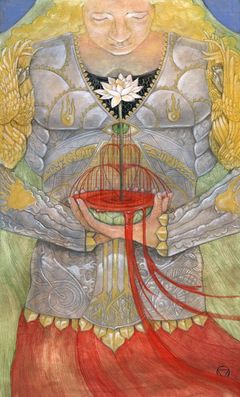My first deck of tarot cards was a present from my best friend when I was 12 or 14: Karen Kuykendall’s Tarot of the Cat People, reflecting our shared affinity for felines and SFF.
After more than 20 years, this deck and I know each other pretty well. And I tend to feel like the cards reflect some of the boldness and confidence I had as a teenager back to my much more cautious and doubtful adult self, especially when I’m asking about my creative life. They’ve always egged me on to take that leap, throw that hat, do the thing.
Interestingly, they don’t work particularly well for me when it comes to brainstorming for fiction. There’s something about them that’s kind of…straightforward? Simplistic? I find they don’t give me much to go on for these purposes, although I’ve always liked the descriptions in their book and the nuanced array of key words and phrases supplied, and they've always served me well for the real world and my own life. Maybe I'm just too accustomed to that context for them.
Though the Tarot of the Cat People was where I learned the meanings of the cards, for a tarot spread appearing in scene in a book, I chose to use the Rider-Waite Tarot, since that’s the “classic” tarot imagery.
Interestingly, they don’t work particularly well for me when it comes to brainstorming for fiction. There’s something about them that’s kind of…straightforward? Simplistic? I find they don’t give me much to go on for these purposes, although I’ve always liked the descriptions in their book and the nuanced array of key words and phrases supplied, and they've always served me well for the real world and my own life. Maybe I'm just too accustomed to that context for them.
Though the Tarot of the Cat People was where I learned the meanings of the cards, for a tarot spread appearing in scene in a book, I chose to use the Rider-Waite Tarot, since that’s the “classic” tarot imagery.
I still need to pick up a copy of this deck at some point. It feels sort of neutral or impersonal to me – like, I don’t know, a dictionary – which is maybe why I haven’t gotten to it yet. Hard to shell out for reference material, as comprehensive and useful as it may be.
I didn’t, however, hesitate to shell out for a copy of the Mary-El Tarot. After my friend Amazon used it to do a story-related reading for me, I knew I'd found my fiction deck.
I didn’t, however, hesitate to shell out for a copy of the Mary-El Tarot. After my friend Amazon used it to do a story-related reading for me, I knew I'd found my fiction deck.
Part of what fascinated me was the illustrations: vivid, splashy, surreal, dramatic. There’s an emotional heft to them, to their weird, lush symbolism. And the book that came with, while kind of rambly and, well, “woo” for my taste, puts a fresh spin on the traditional meanings of the cards that’s been very helpful.
And the ethos of the deck just plain appeals to me. From the introduction:
“Nietzsche said, ‘Battle not with monsters, lest ye become a monster, and if you gaze for long into the abyss, the abyss gazes also into you.’ Thus he expresses the innate fear we have of the abyss, that even to brush against it, no matter how good our intentions, we will be tainted by it. The abyss is most simply, but not only, introspection – looking within yourself. At first that sounds easy to do, but like the abyss, the calm surface is deceptive and in truth it is a bottomless pit that contains many demons and monsters. But, it also contains your own true will: everything you ever wanted to know, and your salvation, but you must be willing to dive, or be foolish enough to stumble.”
I LOVE this. It says so much to me about what kind of project spooky fiction really is. I don’t know – I feel like these cards get me, even if I haven’t totally wrapped my head around them yet. I feel like they give me permission to be emo and dramatic and tell self-consciousness to back the fuck off for a while.
Reader, tell me about your favourite decks! What draws you to them? What speaks to you about them? Any particularly useful for writing, and if so, how so?
And the ethos of the deck just plain appeals to me. From the introduction:
“Nietzsche said, ‘Battle not with monsters, lest ye become a monster, and if you gaze for long into the abyss, the abyss gazes also into you.’ Thus he expresses the innate fear we have of the abyss, that even to brush against it, no matter how good our intentions, we will be tainted by it. The abyss is most simply, but not only, introspection – looking within yourself. At first that sounds easy to do, but like the abyss, the calm surface is deceptive and in truth it is a bottomless pit that contains many demons and monsters. But, it also contains your own true will: everything you ever wanted to know, and your salvation, but you must be willing to dive, or be foolish enough to stumble.”
I LOVE this. It says so much to me about what kind of project spooky fiction really is. I don’t know – I feel like these cards get me, even if I haven’t totally wrapped my head around them yet. I feel like they give me permission to be emo and dramatic and tell self-consciousness to back the fuck off for a while.
Reader, tell me about your favourite decks! What draws you to them? What speaks to you about them? Any particularly useful for writing, and if so, how so?



 RSS Feed
RSS Feed
